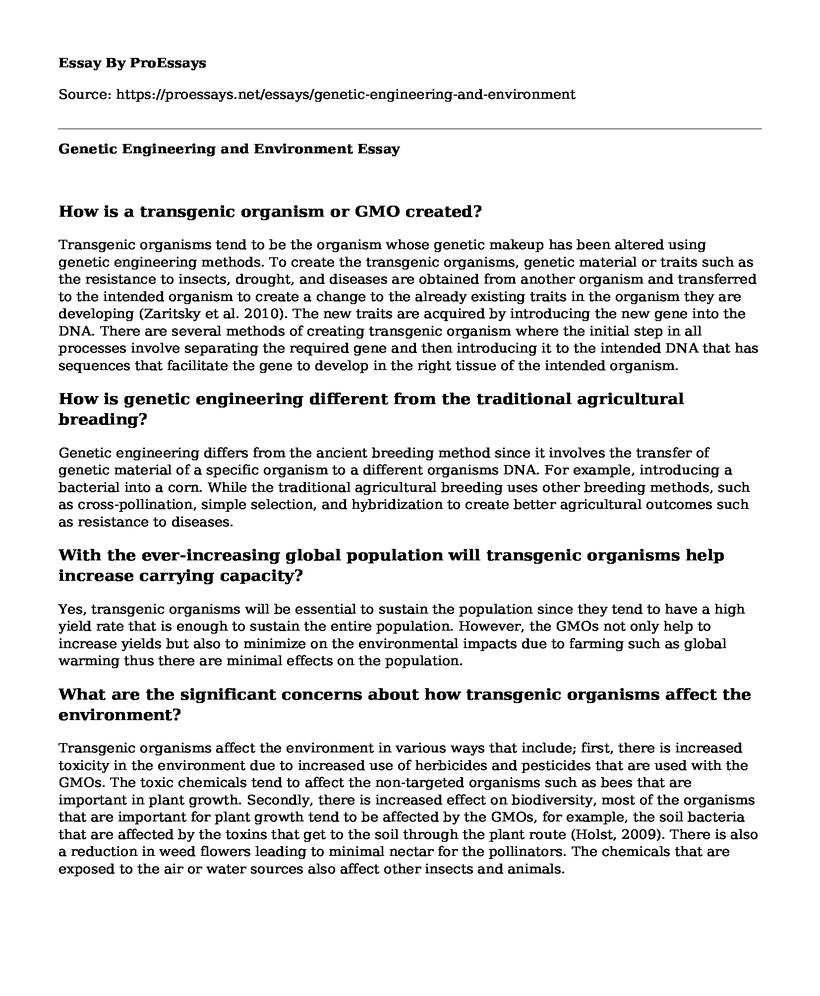How is a transgenic organism or GMO created?
Transgenic organisms tend to be the organism whose genetic makeup has been altered using genetic engineering methods. To create the transgenic organisms, genetic material or traits such as the resistance to insects, drought, and diseases are obtained from another organism and transferred to the intended organism to create a change to the already existing traits in the organism they are developing (Zaritsky et al. 2010). The new traits are acquired by introducing the new gene into the DNA. There are several methods of creating transgenic organism where the initial step in all processes involve separating the required gene and then introducing it to the intended DNA that has sequences that facilitate the gene to develop in the right tissue of the intended organism.
How is genetic engineering different from the traditional agricultural breading?
Genetic engineering differs from the ancient breeding method since it involves the transfer of genetic material of a specific organism to a different organisms DNA. For example, introducing a bacterial into a corn. While the traditional agricultural breeding uses other breeding methods, such as cross-pollination, simple selection, and hybridization to create better agricultural outcomes such as resistance to diseases.
With the ever-increasing global population will transgenic organisms help increase carrying capacity?
Yes, transgenic organisms will be essential to sustain the population since they tend to have a high yield rate that is enough to sustain the entire population. However, the GMOs not only help to increase yields but also to minimize on the environmental impacts due to farming such as global warming thus there are minimal effects on the population.
What are the significant concerns about how transgenic organisms affect the environment?
Transgenic organisms affect the environment in various ways that include; first, there is increased toxicity in the environment due to increased use of herbicides and pesticides that are used with the GMOs. The toxic chemicals tend to affect the non-targeted organisms such as bees that are important in plant growth. Secondly, there is increased effect on biodiversity, most of the organisms that are important for plant growth tend to be affected by the GMOs, for example, the soil bacteria that are affected by the toxins that get to the soil through the plant route (Holst, 2009). There is also a reduction in weed flowers leading to minimal nectar for the pollinators. The chemicals that are exposed to the air or water sources also affect other insects and animals.
How are different types of farming different in their impact on the environment?
The farming methods differ in their environmental impact depending on the various factors such as the type of soil the farming method is practiced, the region in which the farming method is implemented and the weather pattern of the area.
References
Holst-Jensen, A. (2009). Testing for genetically modified organisms (GMOs): Past, present, and future perspectives. Biotechnology Advances, 27(6), 1071-1082.
Zaritsky, A., Ben-Dov, E., Borovsky, D., Boussiba, S., Einav, M., Gindin, G., ... & Yagil, E. (2010). Transgenic organisms expressing genes from Bacillus thuringiensis to combat insect pests. Bioengineered bugs, 1(5), 341-344.
Cite this page
Genetic Engineering and Environment. (2022, Mar 10). Retrieved from https://proessays.net/essays/genetic-engineering-and-environment
If you are the original author of this essay and no longer wish to have it published on the ProEssays website, please click below to request its removal:
- Different Regulations of GMOs in Different Countries
- The Role of Chromatin in Transcriptional Control of Gene Expression
- Argumentative Essay: Animal Testing Should Be Forbidden
- Research Paper on Critical Habitat for the Candy Darter
- Essay Example on Zoos and Aquariums: Protecting Animals and Improving Lives
- Essay Sample on Humans-Environment Interactions: A Constant Struggle for Survival
- Innate Ambition: Unveiling the Nature of Human Drive for Success - Free Paper Example







